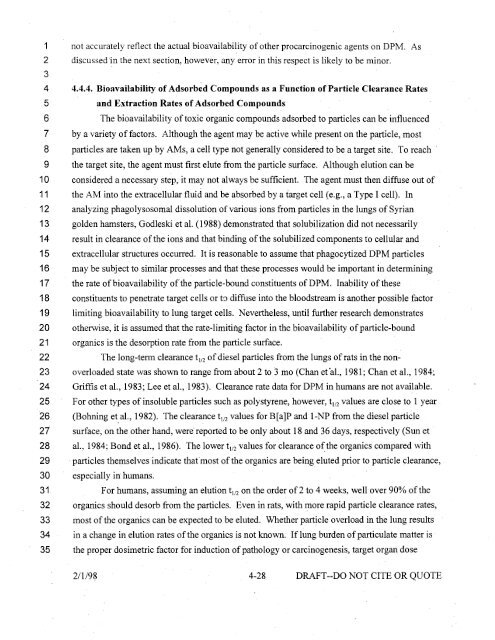Health Assessment Document for Diesel Emissions - NSCEP | US ...
Health Assessment Document for Diesel Emissions - NSCEP | US ...
Health Assessment Document for Diesel Emissions - NSCEP | US ...
Create successful ePaper yourself
Turn your PDF publications into a flip-book with our unique Google optimized e-Paper software.
1 not accurately reflect the actual bioavailability of other procarcinogenic agents on DPM. As<br />
2 discussed ·in the next section, however, any error in this respect is likely to be minor.<br />
3<br />
4 4.4.4. Bioavailability of Adsorbed Compounds as a Function of Particle Clearance Rates<br />
5 and Extraction Rates of Adsorbed Compounds<br />
6 The bioavailability of toxic organic compounds adsorbed to particles can be influenced<br />
7 by a variety of factors. Although the agent may be active while present on the particle, most<br />
8 particles are taken up by AMs, a cell type not generally considered to be a target site. To reach ·<br />
9 the target site, the agent must first elute from the particle surface. Although elution can be<br />
1 0 considered a necessary step, it may not always be sufficient. The agent must then diffuse out of<br />
11 the AM into the extracellular fluid and be absorbed by a target cell (e.g., a Type I cell). In<br />
12 analyzing phagolysosomal dissolution of various ions from particles in the lungs of Syrian<br />
13 golden hamsters, Godleski et al. ( 1988) demonstrated that solubilization did not necessarily<br />
14 result in clearance of the ions and that binding of the solubilized components to cellular and<br />
15 extracellular structures occurred. It is reasonable to assume that phagocytized DPM particles<br />
16 may be subject to similar processes and that these processes would be important in determining<br />
17 the rate of bioavailability ofthe particle-bound constituents of DPM. Inability of these<br />
18 constituents to penetrate target cells or ta diffuse into the bloodstream is another possible factor<br />
19 limiting bioavailability to lung target cells. Nevertheless, until further research demonstrates<br />
20 otherwise, it is assumed that the rate-limiting factor in the bioavailability of particle-bound<br />
21 organics is the desorption rate from the particle surface.<br />
22 The long-term clearance t 112 of diesel particles from the lungs of rats in the non-<br />
23 overloaded state was shown to range from about 2 to 3 mo (Chan efal., 1981; Chan et al., 1984;<br />
24 Griffis et al., 1983; Lee et al., 1983). Clearance rate data <strong>for</strong> DPM in humans are not available.<br />
25 For other types of insoluble particles such as polystyrene, however, t 112 values are close to 1 year<br />
26 (Bohning et. al., 1982). The clearance t 112 values <strong>for</strong>B[ a ]P and 1-NP from the diesel particle<br />
27 surface, on the other hand, were· reported to be only about 18 and 36 days, respectively (Sun et<br />
28 al., 1984; Bond et al., 1986). The lower t 112 values <strong>for</strong> clearance of the organics compared with<br />
29 ·particles themselves indicate thafmost of the organics are being eluted prior to particle clearance,<br />
30 especially in humans.<br />
31 For humans, assuming an elution t 112 on the order of2 to 4 weeks, well over 90% of the<br />
32 organics should desorb from the particles. Even in rats, with more rapid particle clearance rates,<br />
33 most of the organics can be expected to be eluted. Whether particle overload in the lung results<br />
34 in a change in elution rates of the organics is not known. If lung burden of particulate matter is<br />
35 the proper dosimetric factor <strong>for</strong> induction of pathology or carcinogenesis, target organ dose<br />
2/1198 4-28 DRAFT--DO NOT CITE OR QUOTE















